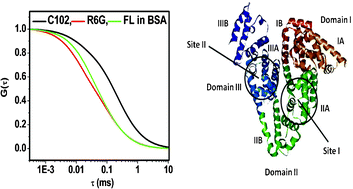Diffusion of organic dyes in bovine serum albumin solution studied by fluorescence correlation spectroscopy†
Abstract
The understanding of the transport of

* Corresponding authors
a
School of Chemistry, University of Hyderabad, Hyderabad, India
E-mail:
assc@uohyd.ernet.in
The understanding of the transport of

 Please wait while we load your content...
Something went wrong. Try again?
Please wait while we load your content...
Something went wrong. Try again?
S. Patra, K. Santhosh, A. Pabbathi and A. Samanta, RSC Adv., 2012, 2, 6079 DOI: 10.1039/C2RA20633A
To request permission to reproduce material from this article, please go to the Copyright Clearance Center request page.
If you are an author contributing to an RSC publication, you do not need to request permission provided correct acknowledgement is given.
If you are the author of this article, you do not need to request permission to reproduce figures and diagrams provided correct acknowledgement is given. If you want to reproduce the whole article in a third-party publication (excluding your thesis/dissertation for which permission is not required) please go to the Copyright Clearance Center request page.
Read more about how to correctly acknowledge RSC content.
 Fetching data from CrossRef.
Fetching data from CrossRef.
This may take some time to load.
Loading related content
